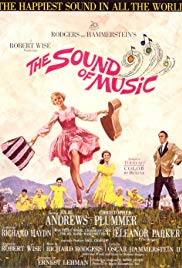If your children are very young, ages 6 – 8, just enjoy the film and the music. For children, 9 – 11 describe the Nazis briefly and their takeover of Austria. See the Helpful Background section. For children 12 – 15 ask and help them to answer the Quick Discussion Question. For children interested in knowing how things work, describe thunder and lightning. See the Thunder and Lightning in the Helpful Background section.
THE HISTORICAL CONTEXT
The story told in the musical is true, differing from the real story only in a few details, e.g., the family escaped in two automobiles and not on foot. The Von Trapps did not return to Austria after WWII, but settled in the United States. They arrived in New York with only $4 in their pockets. At first they made their living as touring musicians. After fourteen years they established a music camp in Vermont, naming it “Little Austria.” The Baron, who had been a decorated submarine commander in the First World War, died in 1947. Maria Von Trapp lived until 1987, reaching the age of 82. Maria Von Trapp’s only complaint about the musical was that it portrayed her as a “goody-goody.”
On March 12, 1938, Nazi troops peacefully entered Austria to effect the union of Austria and Germany. This was called the “Anschluss”. Germany and its friends in Austria claimed that there was a common Austro-German language and culture and that Austria should be a part of the Third Reich. As shown in the movie, the few Austrians who opposed the Anschluss were drowned out in a chorus of “Heil Hitlers.”
Most Austrians have never seen this film and the story of the Von Trapp family is not well known in that country. “Edelweiss” is not a particularly popular song in Austria. It is not a kind of folk national anthem as implied by this film. This movie is meaningful primarily to audiences in the U.S.
THUNDER AND LIGHTNING
The tops of clouds carry a positive electric charge but the bottoms of clouds are negatively charged, as is the Earth. The cloud sparks as a lightning bolt when the difference in the charges is great enough. About 65% of the occurrences of lightning are in a single cloud or from one cloud to another. Only about 35% of lightning bolts hit the earth. The speed of lightning can vary, but it is usually about 90 miles per second (143 KM per second). A lightning bolt has an inner core of about one inch consisting of the electrical charge and an outer core which consists of glowing ionized particles. When the electrical charge hits the ground, a counterstroke goes back up through the same route to the cloud. This is so rapid that we can’t see it.
Lightning is hot: about 30,000 degrees Fahrenheit or 16,700 degrees Celsius. It heats the surrounding air which then expands at supersonic speed. A sonic boom (thunder) is produced as the air moving away from the lightning breaks the sound barrier. The light from a lightning bolt travels at the speed of light. Thunder travels at the speed of sound which is much slower. If you are far away from a lightning strike, you will see the lightning several seconds before you hear the thunder. You can determine approximately how far you are from the lightning strike by counting the seconds between the lightning flash and the thunder and then dividing by five for the distance in miles, or by three for the distance in kilometers.
THE TELEGRAPH
The telegraph was the first practical method of sending information electronically. It came into common use in the first half of the 19th century. It has only recently been replaced by teletype, facsimile, and next day delivery services. Even after the telephone came into widespread use, messages that were important were sent by telegraph. The company that obtained a monopoly on telegraph service in the United States was called Western Union. In a telegram, the word “stop” would be used to indicate the end of a sentence.



